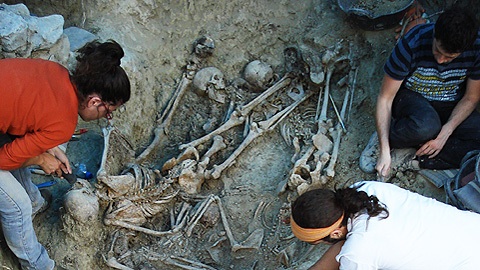Improvements to genetic studies of skeletal remains from the Civil War

19/06/2015
The UAB researcher Assumpció Malgosa, a lecturer in the Biological Anthropology Unit and head of the Osteobiography Research Group, together with the UPF researchers Ferran Casals, head of the Genomics Service and a lecturer in the Department of Experimental and Health Sciences at the UPF, and Jaume Bertranpetit, of the Institute of Evolutionary Biology (CSIC-UPF), have presented a pioneering forensic genetics study of remains from a Spanish Civil War mass grave.
In the words of Ferran Casals, this research, commissioned by the Ministry of Governance and Institutional Relations of the Government of Catalonia (Generalitat), means that "next-generation genetic studies have been made for the first time on skeletal remains from the Spanish Civil War, with extraordinarily good results, which will open the door to identifying these remains with a high level of reliability".
The study analysed the genetic material extracted in 2008 from the human remains that were recovered and identified in the grave at Gurb (Osona). At that time, using validated forensic genetic markers, only incomplete DNA profiles could be obtained, due to the high degree of degradation of the remains.
According to the researchers, “The work we have done opens the way to conducting a sufficiently broad study of the Civil War remains already exhumed, and also of any that might be recovered in future. This methodology can establish the precise identity of the persons whose remains have been recovered". The scientists see this as a pioneering study that will serve as a reference point when presenting this new technology that has just been launched.
Thanks to the use of next-generation genome-sequencing technology, exhaustive genetic information can be obtained to establish a very complete genetic profile. This in turn, once a similar profile has been made for living relatives, can lead to a highly-reliable identification, even for second-degree relatives. Until now, this had not been possible due to the state of degradation of the genetic material analysed: the DNA.
The new system used was specifically designed for the analysis of highly degraded forensic samples. Based on NGS (Next Generation Sequencing) techniques, it amplifies much smaller DNA fragments and yields up to 200 genetic markers that include information on phenotypes, such as estimations of eye or hair colour.
The study was carried out with the help of Illumina, a leading company in next-generation genome-sequencing technology.
An expert on forensic anthropology
The UAB researcher involved in this study, Assumpció Malgosa, also coordinated the recent work done on recovering and identifying persons who disappeared during the Civil War, commissioned by the Generalitat. This work served to draw up the protocol that defines the measures to be taken by the Generalitat under the terms of the Law on Mass Graves.
Dr Malgosa, a professor in the Department of Animal and Plant Biology and Ecology and a researcher in the Biological Anthropology Unit of the UAB – where she heads the Ancient DNA Laboratory – is an expert in the reconstruction of ancient populations through the study of human remains, and in forensic anthropology.
Related news:
Remains of 13 bodies found in the mass grave at Gurb
Gurb mass grave: 4 republican soldiers identified
New Civil War mass graves found in La Serra de Riés